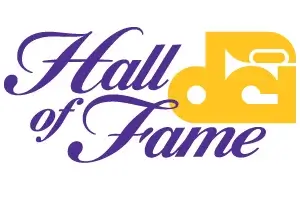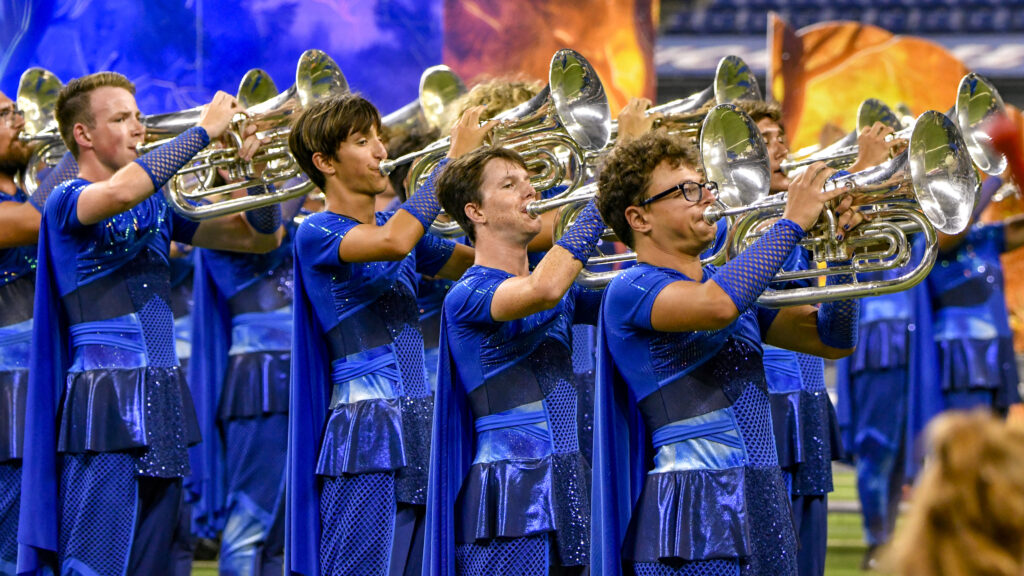 Since 1985, the Drum Corps International Hall of Fame has honored individuals who have left their indelible impressions on the drum corps activity.
Each winter, members of the drum corps community participate in a nomination process, informing DCI’s Hall of Fame Committee of those whom they feel should be recognized as part of drum corps’ legacy. Come April, current Hall of Fame members and corps directors participate in an election process to decide who will join the ranks of this prestigious society.
Four individuals have been selected for induction as the DCI Hall of Fame Class of 2011.
Since 1985, the Drum Corps International Hall of Fame has honored individuals who have left their indelible impressions on the drum corps activity.
Each winter, members of the drum corps community participate in a nomination process, informing DCI’s Hall of Fame Committee of those whom they feel should be recognized as part of drum corps’ legacy. Come April, current Hall of Fame members and corps directors participate in an election process to decide who will join the ranks of this prestigious society.
Four individuals have been selected for induction as the DCI Hall of Fame Class of 2011. Michael Gaines
Cavaliers visual designer
In a corps that earned its nickname the “Green Machine” based on the visual designs of such Hall of Fame greats as Len Piekarski and the late Steve Brubaker, Michael Gaines had some big shoes to fill when he first started writing the Cavaliers’ drill formations in his 20s.
Now, more than a decade on the job, he continues to create awe-inspiring visual effects on the football field that leave fans on the edges of their seats asking in amazement, “How’d they do that?
“He truly is the ‘Botticelli’ of present day drill design,” said Hall of Fame member James Elvord. “Single handedly, Michael has pushed all designers to explore the outer limits of sheer visual excitement. Michael’s work mesmerizes the audience with its brilliant clarity and technical difficulty. No one writing today creates effects on this grand a scale.”
Gaines was a member of the Cavaliers’ color guard section from 1987 to 1990. Joining its staff the following year, he had his first taste of the drum corps design process writing choreography for the color guard. Lending his hand to parts of the drill design in both 1992 and 1993, it wasn’t until the Cavaliers’ 50th anniversary season in 1998 that Gaines took on the full responsibility of the corps’ visual package.
Still crafting the Green Machine’s visual productions today, Gaines has made his mark while helping the corps achieve an unprecedented five World Championship titles in the 2000s.
A 2007 inductee to the Winter Guard International Hall of Fame, outside of the drum corps arena, Gaines is an active designer, adjudicator and clinician for marching bands and color guards around the world.
His work in the marching arts both on and off the drum corps field continues to inspire designers of the past, present and future.
“We have seen many good designers and a handful of very good. Then there is the all-time list of drill designers,” said Hall of Fame visual designer Marc Sylvester. “I believe that it is the quality and consistency of Michael’s work that puts him in the league of the very best Drum Corps International has seen.”
Ken Norman
Brass arranger and innovator
Some DCI Hall of Fame members’ legacy and influence on the drum corps activity started well before the formation of Drum Corps International in 1972, and such is the case with Ken Norman.
In the early 1960s still as a French horn-playing member of the Racine Kilties, Norman got his start arranging music for the corps’ brass section. Always eager to improve and do more with his compositions, he found himself limited by the instrumental restrictions placed on corps by the veteran’s organizations that governed the competitions of that time period.
Wishing to utilize brass instruments that weren’t as limited in range and flexibility as the traditional military bugles, Norman orchestrated a change that many to this day consider one of the most significant historical milestones in the evolution of drum corps instrumentation.
Hall of Fame member Dave Richards wrote in a 2000 Drum Corps International Magazine article: “Headed by Ken Norman, top musicians in the activity developed a G [keyed] bugle with the valve tuned in F and a rotary valve tuned in B-flat. In essence, they created an instrument that mirrored the trumpet’s first and second valve and made the bugle a legitimate instrument. It not only brought greater notation opportunities for the instrument, but it brought greater musicians into the activity—arrangers, instructors, performers. The activity had finally gained the recognition as a worthwhile musical activity, and the recognized precision of the past continued to rise.”
Norman not only helped craft the proposal that would ultimately convince the VFW to accept this new style of bugle in competitions, he would help manufacturer a custom set of the instruments for the 1968 Kilties horn line to showcase the new technology along with an advanced musical arrangement to go with it.
The ’68 Kilties horn line made history. Hall of Fame member Jack Meehan complementing the innovation of Norman and his group said, “[Ken] gave us all a glimpse into the future and a taste of what was possible.”
For more than four decades, Norman has composed or is credited for the brass arrangements of a staggering number of junior, senior and alumni corps, including the Kilties, Anaheim Kingsmen and Argonne Rebels, among a list of no less than 65 others. Beyond composing and arranging, he is also credited for developing new adjudication captions that form the cornerstone of today’s judging system used in Drum Corps International competitions.
“It was Ken whose significant influence made it possible to overcome the inertia of locked-in an archaic rules of the national veterans’ organizations and freed the activity to achieve excellence as an art form,” said Hall of Fame member Glenn Opie. “In doing so, legions of kids and adults learned teamwork, how to achieve excellence with enhanced spirit, and the discipline that resulted in successfully handling life and its endless number of trials.”
Daniel Richardson
Phantom Regiment program coordinator
A corps as rich in history as the Phantom Regiment, few individuals have had the long and lasting impact as that of Dr. Daniel Richardson.
A member of the corps in its early years from 1956 to 1964, Richardson, or simply “Dr. Dan,” as he’s affectionately known within the organization, began his tenure as program coordinator with Phantom Regiment in 1972, overseeing the corps’ staff members and creative design process.
Hall of Fame member Jim Wren credits Richardson as a pioneer. “[Dr. Dan] was one of the earliest individuals to recognize the need for someone to coordinate the work of the individual caption heads,” he said.
Additionally serving in a variety of roles including corps director and board member, Richardson’s personal impact on the thousands of corps and staff members who have been a part of Phantom Regiment is what he has especially been come to be known for.
John Madden, Michigan State University Associate Director of Bands and a Regiment alum and former staff member in the 1980s, has always been impressed with how Richardson not only served as a management figurehead within the corps, but also how he played so many additional roles as diverse as medical doctor, nutritionist, leadership consultant, mentor and friend to all who he was around.
“[Drum corps] wasn’t a hobby or weekend activity, it was at the center of [his] very being,” said Madden. “Dr. Dan Richardson displayed this loyalty through his caring nature, his personal financial contributions, his relentless standards of excellence, his ability to motivate and inspire, and his instinct to care for and comfort each and every member of the Phantom Regiment. “
“It is Dr. Dan’s positive and remarkable influence on the human condition that really allows him to rise above,” said former Phantom Regiment visual designer Myron Rosander. “It is through his amazing support of our most precious commodity, our kids, where Dr. Dan’s light shines the brightest.”
Richardson continues to be an integral part of Phantom Regiment organization severing as a member of the corps’ board of directors and as a program advisor to its team of designers. A successful medical doctor outside of the drum corps activity, even with numerous commitments to travel and lectures, Phantom Regiment Executive Director Rick Valenzuela says Richardson, “always has time for us and the drum corps activity. He continues to be an influence that is unmatched.”
“In a world dominated by self importance, titles, statistics and inflamed opinion, it is Dr. Dan’s humble presence to the staff and students which make him the invaluable resource that he is,” said Rosander. “These virtues are often difficult to measure, yet they are the fundamental ground zero of what makes our beloved activity so outstanding.”
Todd Ryan
Visual caption head and marching instructor
For more than 30 years, Todd Ryan has proudly worked “down in the trenches,” teaching corps members how to march, while demonstrating his profound ability to “clean” the most complicated drill forms and movements.
“The practitioners/cleaners are sometimes looked upon as occupying a somewhat less glamorous step on the scale of who most influences the drum corps activity,” said Hall of Fame member James Elvord. “Todd through mastery of his craft has shattered that tradition and has shown there is pure genius in the practical art of teaching. Todd is considered among the best, if not the best of all present day movement technicians.”
Ryan got his start in drum corps in the 1970s first as a member of the 32nd Hussar, before spending seven years with the Madison Scouts from 1973-79. He went on to serve as a staff member with a number of corps including the Madison Scouts, Les Eclipses, Star of Indiana, Pioneer, and the Blue Devils where he still teaches today.
Many dedicated and extremely talented individuals make a career in drum corps never having the opportunity to instruct a group that has won a DCI World Championship. Ryan has not only achieved that feat with one corps, he’s done it with four, including the Madison Scouts (1988), Pioneer (1991, 1995), Star of Indiana (1991), and the Blue Devils where he’s been involved with an incredible string of eight championship titles since 1994.
Even with that almost unimaginable competitive success to his credit, Ryan continues to do his job with a trademark understated and modest demeanor.
“One thing that strikes me about Todd is his unassuming nature. He is always in the background,” said DCI judge and Hall of Fame member George Oliviero. “He prefers do his work with the corps members and doesn’t wish to be a visible part of celebrations and [judge] critiques, etc. That leads me to understand that his work is FOR the members!”
As drum corps performances have become more advanced and physically demanding, Ryan has been instrumental in developing new techniques to allow corps members to execute difficult maneuvers while playing, marching and maneuvering at fast tempos.
According to former Star of Indiana Director James Mason, who brought Ryan in to be a part of his corps’ staff in 1989, “The technique that Todd perfected [with Star in the early 1990s] is currently one of the most successful marching styles that we have today.”
Ryan’s lasting legacy will no doubt be one that is measured by the sheer number of corps members he has instructed, many whom have gone on to become visual staff members and caption heads for top drum corps and marching bands across the country.
“Great teachers are the ‘life blood’ of great organizations,” said former Blue Devils Director and Hall of Fame member Michael Moxley. “Todd Ryan’s impact on the performance and competitive achievements of the Blue Devils has been tremendous, and the drum corps activity has been the beneficiary of scores of new teachers that have learned under the skilled direction of this ‘master of the art.'”





